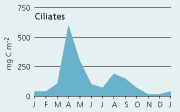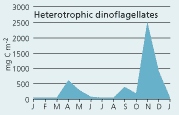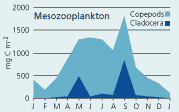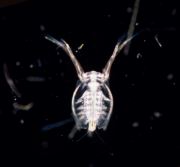
| Map of Danish marine waters | ||
| The cladoceran Penilia avirostris | ||
| Figures 2.24 Seasonal variation in biomass (mg C m-2) of ciliates, heterotrophic dinoflagellates and mesozooplankton in the southern part of Kattegat. (Modified from Nielsen & Hansen 1999).
|
 |
| Ciliates |
 |
| Heterotrophic dinoflagellates |
 |
| Mesozooplankton |
| Figure
2.25 The cladoceran Penilia avirostris, which is probably now established in Danish waters. Photo: Per Juel Hansen. |
 |
Zooplankton
The zooplankton are an important link between the phytoplankton and higher trophic levels such as fish. Zooplankton constitute a diverse group of organisms with respect to size, life cycle and behaviour. The smallest size class, nanozooplankton (2-20 µm), are single celled organisms. The larger size class, the microzooplankton (20-200 µm) are dominated by ciliates and heterotrophic dinoflagellates, small metazooans as rotiferans and the earliest developmental stages of copepods. The largest size class, mesozooplankton (> 200 µm), consist of copepods, cladocerans and larvae of benthic invertebrates. The more conspicuous jellyfish often dominates the gelatinous plankton.
Due to the doubtful usefulness of zooplankton as an indicator of eutrophication, zooplankton have been given relatively low priority in the Danish monitoring programme with respect to the number of sampling stations and sampling frequency. From 1998 zooplankton was given even lower priority in open waters, but is still included in the monitoring of many coastal waters.
In general the diversity of the zooplankton community decreases with salinity from the North Sea to the Baltic Sea and from the open sea to the low salinity estuaries. However, diversity is high in the Kattegat and the Belt Sea due to the influence of both brackish and Atlantic species as a result of the inflow of water from the Baltic Proper and the Skagerrak-North Sea, respectively. The relative importance of protozooplankton, rotiferans, meroplankton and cladocerans is highest in the estuaries and decreases gradually towards the open sea. Conversely, the importance of copepods increases towards the sea.
During the period 1983-96 the winter biomass of mesozooplankton was generally low (2-5 mg C m-3) in the open waters, increasing to a seasonal summer peak of about 30-40 mg C m-3. Interregional differences were minor, also with respect to species composition. An analysis of copepod biomass data revealed a significant but only slight reduction in the mesozooplankton biomass from 1989 to 1997 at two out of three Kattegat stations (Ærtebjerg et al. 1998).
In the estuaries the composition and seasonal succession of the zooplankton community is much more variable than in the open sea. Both seasonal successions and time trends differ markedly among the estuaries monitored. In the Limfjord the mesozooplankton biomass has increased significantly since 1985, while the biomass of protozooplankton has decreased, though not significantly. In Ringkøbing Fjord the biomass of mesozooplankton has decreased significantly since 1989 while the protozooplankton biomass has increased, though not significantly. In Roskilde Fjord no time trend was observed in the biomass of either meso- or protozooplankton. The lack of general inter-fjord time trends is probably due to the effect of local conditions.
Eutrophication is believed to cause an increase in the relative importance of gelatinous zooplankton vs. crustacean zooplankton. Throughout the monitoring period several estuaries like Roskilde Fjord, Kertinge Nor and Limfjorden have suffered from occasional blooms of gelatinous zooplankton such as the jellyfish Aurelia aurita (Frederiksborg Amt & Roskilde Amt 2002, Fyns Amt 2002). The jellyfish graze on the mesozooplankton, which in turn leads to lowered grazing on the phytoplankton. In Kertinge Nor it has been shown that high abundance of jellyfish reduces the importance of zooplankton as grazers on phytoplankton to almost negligible levels (Petersen et al. 1999). Moreover, jellyfish are suspected to affect the recruitment of fish negatively, both by grazing on fish eggs and larvae and by affecting the feeding conditions for fish larvae and planktivorous fish by causing a decrease in the abundance of prey organisms such as copepods. Jellyfish themselves are in a sense a trophic dead end. Energy and organic matter that could otherwise be channelled into harvestable organisms is turned into non-utilisable jelly.
THE CLADOCERAN PENILIA AVIROSTRIS:
AN ADDITION TO THE DANISH FAUNA
Cladocerans
have their main distribution in freshwater habitats and the number of
species in Danish marine water is limited. Usually they constitute only
a minor fraction of the mesozooplankton biomass, but due to parthenogenesis
they can increase rapidly in numbers when growth conditions are favourable
and occasionally they become quantitatively important grazers. The two
dominating genera Evadne and Podon are believed to graze
mainly on large phytoplankton cells and on protozooplankton (Egloff
et al. 1997).
In the autumn 2001 a new cladoceran species Penilia avirostris
was observed in plankton samples from Århus Bight and Kattegat (Ærtebjerg
et al. 2002). This species has its main distribution in tropical and
subtropical seas, where it at times dominates the mesozooplankton biomass.
It feeds mostly on nanoplankton (2-20 µm) (Turner
et al. 1988) and thus plays a different role in the pelagic food web
than the other marine cladoceran species. Due to this P. avirostris may
be an important link between bacterioplankton and higher consumers because
of its predation on bacterivorous flagellates. P. avirostris
was reported in the North Sea as early as 1948 and since 1999 it has been
a steady component of the zooplankton community in the southern and eastern
parts of the North Sea, typically in September/October. Since the first
record in the North Sea it has spread progressively northward. For example
it was found around Helgoland (Germany) in the early 1990s and was recorded
in Koster Fjorden (Sweden) in 1997. In 2001 P. avirostris was
observed in relatively low abundances of about 100 individuals m-3 in
the Kattegat region, but in August-September 2002 it was among the dominating
mesozoopankton species in the Sound with abundances up to 4000 individuals
m-3 (Per Juel Hansen,
pers comm). P. avirostris has the capacity to quickly build dense
populations and significantly influence the food web structure and the
fate of the primary production. Therefore it is important to follow closely
the occurrence and development of this new, invasive species which is
probably well established in Danish waters.
| | Top | |
| Next
| |







